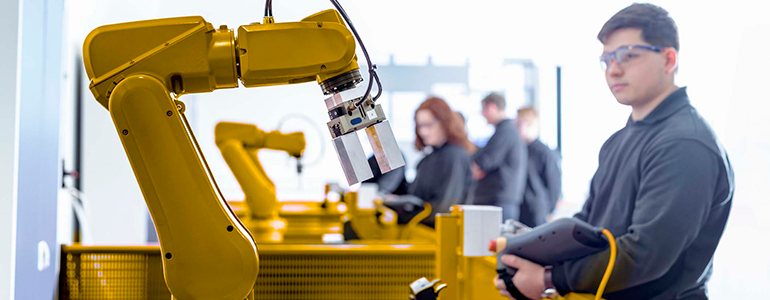Robots & Robotics Series - Part 1

18 Oct 2019
Hazards and Testing
Robotics is a rapidly growing field with applications in multiple industries: collaborative robots (cobots) industrial mobile robots (IMRs), automatic guided vehicles (AGVs), smart mining, autonomous mobile storage for the retail industry, medical robots and robotic personal assistants. As robots and robotics become more prevalent, it is important to understand the hazards and testing options for these innovative devices.
Main Hazards
There are several hazards that need to be assessed and addressed for robots and robotic devices. The main hazards to consider for robotics are:
- Mechanical: Issues related to the design and function of the system
- Electrical: Overall safety and performance of electrical components within the device
- Ergonomic: Related to the design and comfort of the system
- Thermal: Potential to overheat, resulting in fire or other damage
- Acoustical/Noise: Operational issues resulting in noise
- Vibration: Mechanical issues that lead to vibration, noise and damage
- Radiation: Emitted from the system
- Material/substance: Hazards related to the components within the robot
- Environmental: Hazards associated with the specific environment related the machine's intended use
In addition to these individual hazards, it is common to see combinations also arise such as vibration and noise or electrical and thermal.
Testing Options
To assess these hazards, there are several quality assurance and testing areas that may apply. Depending on the hazard, you will need to consider:
- Hazardous locations assessments: Test products used in hazardous location or explosive atmospheres to stringent requirements for these environments.
- Functional safety: Ensure device's fail-safe mechanisms are operating correctly
- Mechanical safety: Assesses machinery and mechanics for performance and safety, including potential risks
- Electrical safety testing: To ensure safe operating standards in relation to the product's use of electricity and that the product meets electrical safety standards
- Battery and battery charger testing: Ensure energy storage technologies meet performance, reliability and safety criteria
- Performance testing: Assessments such as grip, cameras, vibration, and acoustical
- Process evaluations: Risk management, programmable electrical medical systems, usability
- Environmental testing: Assess hazards related to intended environment and ensure product performance and safety
- Electromagnetic compatibility (EMC) & electromagnetic interference (EMI): Ensure the product continues to function when in use around other devices emitting electromagnetic energy and likewise does not interfere with other devices.
- Wireless and cyber security testing: Ensure wireless products meet requirements for connectivity, function and data protection
In addition to understanding potential hazards and testing options, it is critical to know the applicable standards for robots in the region or market a device will enter. In the next blog posts in this series, we will explore robotic standards in the EU.
For more insights on quality and compliance for robots and robotics, download our complimentary fact sheet.

Ang Zhu,
Engineer
Ang Zhu is an engineering lead at Intertek's Cortland New York facility, where he is responsible for certifying power generation and conversion equipment, functional safety consultation, researching new standards and technologies, and providing regional and global technical support and guidance. He is a committee member of IEC 61508 TC 65 and E.I.T in New York State. He received a bachelor's degree from South China University of Technology (SCUT)and master's degree in Electrical Engineering from both SCUT and New York University Tandon School of Engineering